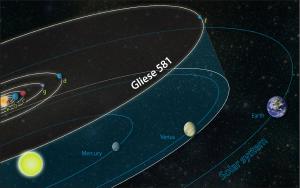Post
Countless Worlds
4 October 2013
 Zina Deretsky, National Science Foundation
Zina Deretsky, National Science FoundationOne of the biggest advances of astronomy in the past decade has been the discovery of planets orbiting other stars, known as exoplanets. But just how many exoplanets have been discovered? According to the Extrasolar Planet Encyclopedia, a semi-official catalog based in Europe, there were as of the end of September last year 990 confirmed exoplanets and 2,321 candidate exoplanets. The discrepancy between these numbers has to do with the limitations of the observational data we currently have.
As an example, consider the star system known as Gliese 581. Gliese 581 has 3 confirmed planets, but likely has at least 4 or 6 worlds. The answer depends on how you model the data. The data for 581 comes from the High Accuracy Radial velocity Planet Searcher (HARPS), which measures the Doppler shift of the star to look for planets.
As planets orbit their star, the gravity of the planet tugs a bit at the star, causing the star to wobble a bit. The amount and rate of that wobble can tell us about the mass and orbit of the planet. We can measure the wobble of a star by measuring how the light of the star shifts slightly in color. As the star moves toward us, its light is shifted slightly to the blue, and as it moves away from us it is shifted slightly to the red. This is known as the Doppler shift, and it is similar to the way sound from a train or car can seem higher or lower in pitch if it is moving toward or away from us.
The difficulty of using the Doppler shift to measure the wobble of a star is two-fold. First, the amount of wobble a star has due to a planet is very small, so the Doppler shifts are small and hard to measure. Second, the surface of the star is not calm, so things like granules and stellar flares can cause their own Doppler shifts. This means the data has a great deal of noise in it.
The way to find the planets is then to take lots of data, and fit this data to possible planetary orbits. When you do this you can get lots of possible fits. Some fits are better than others, but some fits can conflict with each other. You aren’t likely, for example, to find two large planets in orbits that very close to each other because their gravitational interactions would make them unstable.
So to narrow the field of candidate planets, you can run computer simulations of different orbits to see if they are gravitationally stable. Given that Gliese 581 is about 7 – 10 billion years old, any planets that exist should be in orbits stable over billions of years. Using computational models you can then exclude any orbits that are not highly stable.
From the observational data of HARPS and dynamic modeling, there are three planets that are considered confirmed. These are the three innermost planets, with stable and fairly circular orbits. In computer models where the inner planets are allowed to have slightly non-circular orbits, a fourth outer planet matches data fairly well. This one has a relatively elliptical orbit about three times further out than the inner three. Because this planet is further out, its wobble effect on the star is smaller and it is harder to pick out of the observational noise. As a result, this one is considered a candidate planet.
There is an alternative model that assumes all the planetary orbits are circular. In the model they assumed the orbits were exactly circular, which isn’t at all likely, but makes the modelling easier. Fitting this model to the data there could be three outer planets, raising the total to six planets. This would mean there are 3 confirmed and 3 candidate planets in Gliese 581.
So how many planets does this system have? At least 3, likely 4, perhaps (but not likely) 6. More observational data, and more dynamical analysis will resolve things in the end. This fuzziness of numbers exists in lots of other systems, hence the difference between confirmed and candidate planets.
But when you think about it, being able to discover 990 confirmed exoplanets is quite amazing when you consider that a generation ago we had no confirmed planets beyond our solar system.